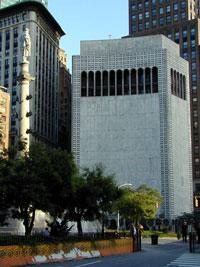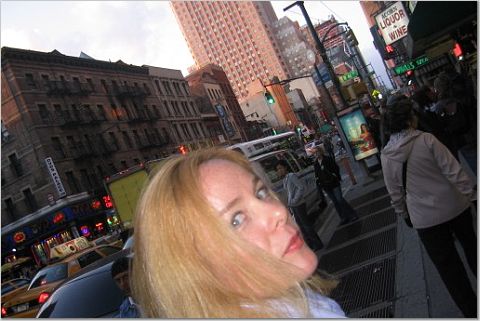 This past weekend in the Arts section, Herbert Muschamp of the Times demonstrated why he achieved such heights as an architecture critic, even if he wasn't always beloved by everyone in that position (he was moved over and replaced by Nicolai Ourousoff). Muschamp's manifesto in defense of Edward Durell Stone's "lollipop" building, The Secret History of 2 Columbus Circle, is one of the most brilliant pieces of cultural/architecture reportage I've read, with these graphs worth quoting at length:
This past weekend in the Arts section, Herbert Muschamp of the Times demonstrated why he achieved such heights as an architecture critic, even if he wasn't always beloved by everyone in that position (he was moved over and replaced by Nicolai Ourousoff). Muschamp's manifesto in defense of Edward Durell Stone's "lollipop" building, The Secret History of 2 Columbus Circle, is one of the most brilliant pieces of cultural/architecture reportage I've read, with these graphs worth quoting at length: I HATE TO BE THE ONE TO TELL YOU THIS, but the old, relentlessly mourned Pennsylvania Station was a dismal piece of architecture. A late arrival in the City Beautiful movement, the building tried to augment meager conviction with extreme colonnades. Walking into its cold, cavernous spaces was like arriving in Philadelphia two hours before you had to.
But so what if Penn Station wasn't Grand Central? It was a crime to tear down a building that had become so deeply impregnated with New York's emotional life. The yawning interiors had a distinctive atmosphere. Like a vast sponge for intense expectations, the station soaked up the psychic energy of arrival, departure, separation, reunion and waiting that had accumulated over the years along with the soot, water damage and flimsy commercial intrusions. The station met the new arrival with a dare: can you make the big city know that you're alive? There's nothing like debased Beaux-Arts design for throwing out a frigid welcome.
A building does not have to be an important work of architecture to become a first-rate landmark. Landmarks are not created by architects. They are fashioned by those who encounter them after they are built. The essential feature of a landmark is not its design, but the place it holds in a city's memory. Compared to the place it occupies in social history, a landmark's artistic qualities are incidental.
To find out why the building is "queer," read the whole article here.